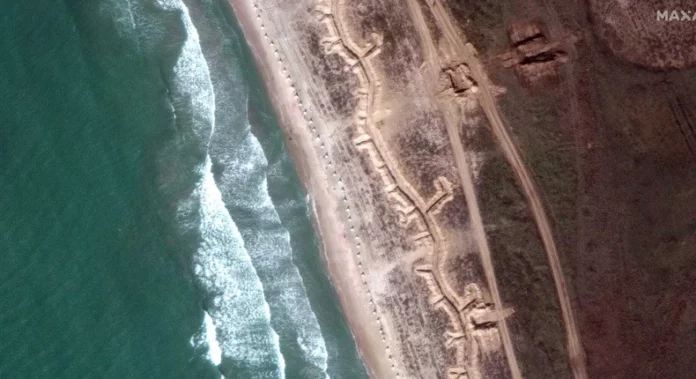- Russian troops have spent the past several months constructing intricate fortifications in Ukraine.
- The engineers building those defensive works are one of the stronger branches of Russia’s military.
- Ukrainian troops now have the tough task of fighting their way through those trenches and barriers.
At battles such as Stalingrad, the Soviets proved to be masters of entrenchment and camouflage. German commanders warned that a Red Army bridgehead had to be counterattacked and destroyed quickly because once the Soviets were dug in, they would be a nightmare to dig out.
Poor military performance in Ukraine has punctured Putin’s fantasy of reviving the Soviet empire. Yet Russian engineers seem to have lost none of their skill. They have created a dense system of fortifications that may stymie Ukraine’s counteroffensive.
“Russian engineering has proven to be one of the stronger branches of the Russian military,” according to a recent report by Britain’s Royal United Services Institute, a think tank.
It’s not that Russia has evolved new tactics. Current Russian fortification doctrine has seen “little methodological change” since the Cold War, according to the RUSI report. Indeed, “Russian constructions follow traditional military plans for entrenchment, largely unchanged since the Second World War,” British military intelligence said in statement about Russian activity in Luhansk in December.
The problem for Ukraine is that since late last year, Russian forces have been building up their defensive positions in eastern Ukraine and along the northern approaches to Crimea. These engineering works include concrete-lined trenches, barbed wire, dragon’s teeth, anti-tank ditches, and plenty of anti-tank and anti-personnel mines, and they “pose a major tactical challenge to Ukrainian offensive operations,” the RUSI report warned.
Each Russian brigade has two engineer companies, which is roughly comparable to the engineer battalion attached to a US brigade combat team. One company focuses on building fortifications, while the other lays and clears mines.
There is an initial line of infantry foxholes. Behind this is a second line of trenches and concrete firing posts, screened by multiple obstacle belts — each a little over a half-mile wide — and comprising barbed wire, dragon’s teeth, and anti-tank ditches about 20 feet wide and 13 feet deep.
The second line isn’t continuously manned but rather consists of company-sized positions in wooded areas and on ridge lines, placed so that the defenses are entirely covered by fire.
The third line, about 3 miles back from the initial outpost line, consists of fallback positions and concealed areas for reserves. And these fortified zones may have several echelons of Russian units. “The overall depth of defensive fortifications exceeds 30 kilometers (19 miles) on some axes,” noted the RUSI report, which was based on interviews with Ukrainian military officers.
Even if engineers aren’t available, Russian troops still dig in. “They are to do so by hand, and are to continue to improve their positions for the duration that they occupy them,” the report said.
Perhaps the most formidable part of Russian defenses are mines, which the Russians “have no shortage of,” according to the report. Russian minefields helped repel a recent attack that resulted in the destruction of several of Ukraine’s new Western-supplied Leopard 2 tanks and Bradley 2 infantry fighting vehicles.
Clearing minefields is difficult because Russian mines have multiple triggers and anti-tampering devices. According to the RUSI report, it’s common for Russian anti-personnel mines “to be initiated by a seismic sensor and to have an immediately adjacent mine initiated by wires, which are laid out in a cross from the device.”
Russia has also laid “instant” fields of magnetically activated anti-tank mines that are deployed using multiple rocket launchers.
Ukraine isn’t totally helpless when dealing with Russian mines and obstacles. Finland has provided a half-dozen modified Leopard 2 mine plows, some of which have already been destroyed. The US has sent Stryker troop carriers fitted with mine plows, as well as obstacle breaching munitions.
The question is whether a limited quantity of specialized engineering equipment will be sufficient to breach dense Russian fortifications and allow Ukrainian armor to exploit the gap.
Also disturbing are two aspects of Russian mine warfare that will complicate future Ukrainian reconstruction efforts.
First, Russian mines “rarely follow a discernible pattern and are seldom marked,” according to RUSI. This will make identification and clearance of those mines that much harder. In addition, Russia did not sign the 1997 Ottawa Treaty banning anti-personnel mines, which has allowed its forces to “freely utilize victim-initiated” anti-personnel mines, RUSI said.
For the US and many other nations, today’s mines are supposed to be detonated by a human operator or to self-destruct after some period of time, but victim-initiated explosives mean that Ukrainians will be setting off mines long after the Russian troops who laid them are gone.
The US has also not agreed to the Ottawa treaty, which calls for the destruction of existing stockpiles of anti-personnel mines, weapons that have killed countless civilians in former war zones. The Pentagon was reluctant to remove the extensive minefields guarding the DMZ between North and South Korea.
The Obama administration announced in 2014 that it would adhere to the treaty with an exception for the land mines the US had placed on the Korean Peninsula. The Trump administration rescinded that policy, but the Biden administration reinstated it in June 2022 — including the Korean exception.





